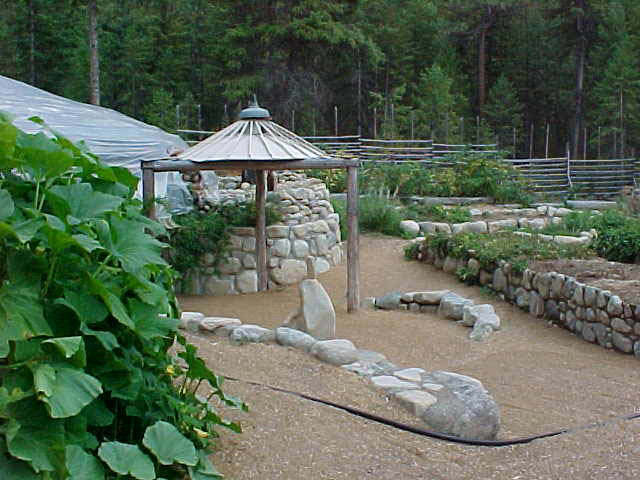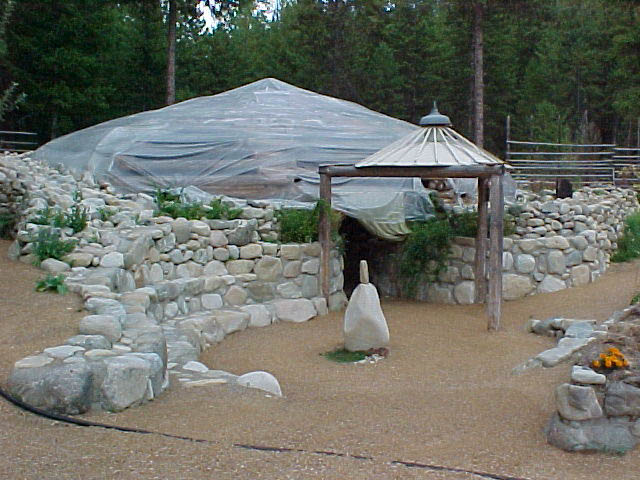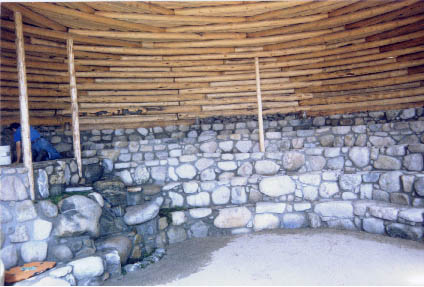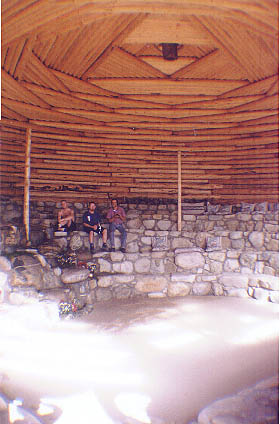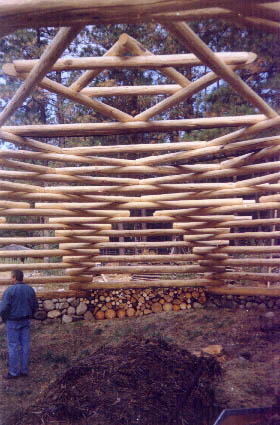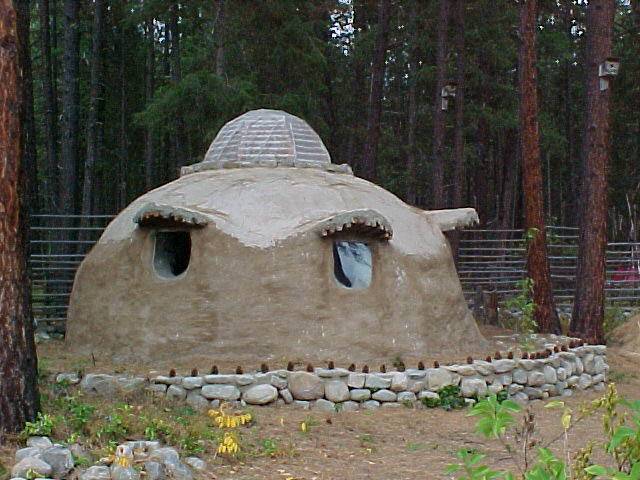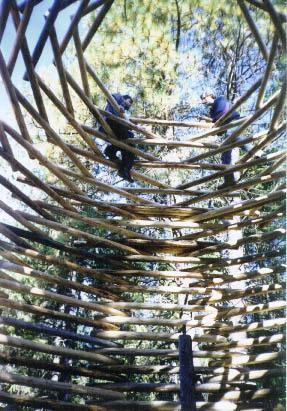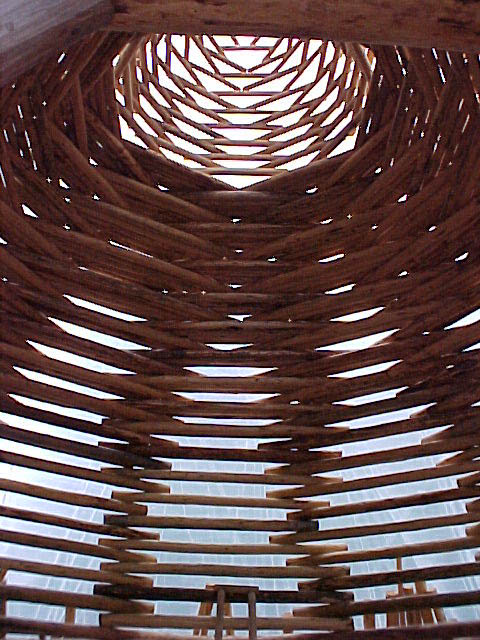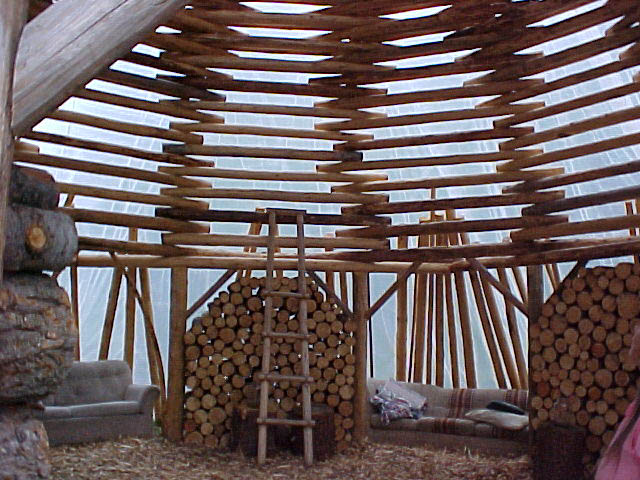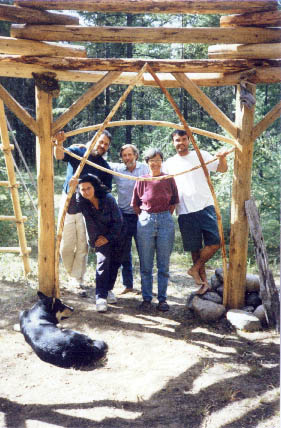Sean and Esther, as they are known by friends have carved and dug themselves a piece of "heaven on earth" in rural Grand Forks. Their unique approach to life and lifestyle is one that many may consider learning a little more about. Sean has had magazine articles written about his paper & glass houses in New Mexico a building material useful in warmer drier climates. When I arrived for our meeting, Sean was busy on the roof, building a new structure that had his trademark, round shape for his northern habitat "the Sanctuary" as it has been called. This structure was taller than the rest though and was being built outside of the deer fenced main housing compound.
OM: What will this building be used for?
Sean: This one will be the Star Chamber, a meeting place connecting the main compound with the Medicine Wheel, for sheltering people when they arrive for the weekend, approximately 24 feet, floor to ceiling and 24 feet in diameter. There will be a inner balcony for drumming, and a central fire place. This one is a little different from the other Kivas that we built, it has a higher arc on the dome roof and the roof starts at 7 feet off ground level, where the others have a lower arc on the roof with the roof being started on the ground and the inside dug out. As it comes up I'm getting ideas how to finish it. Fill the walls with cord wood in a stack wall fashion, dig out the inside and use rocks as building materials and then berm it with the rubble.
OM: You seem to play it by ear and let inspiration tell you how to build as you go along as if you were an artist with a canvas?
Sean: I guess that's how you could describe it. I didn't have a clear conception of what it would look like at first, and as it goes up it surprises me and I get all sorts of ideas for it. The really amazing thing is that in a week you can have the super structure for a house for $50. You cover it with greenhouse plastic and you have a micro-climate. You can be in there digging it out in any kind of weather, heat, rain or snow.
This one will be finished of with clay, salvaged windows and bus seats. It will cost no more than $100 for a 700 square feet of living space. There will be no cost for fuel because we will heat with wood. We use mostly hand tools but now we do have a chainsaw.
OM: How long have you lived here?
Sean: We came in 1985 and just fell in love with the valley. We set up our Tee Pee on the banks of the Granby River here and would go out looking for land in a 50 mile radius. Every time we came back to the Tee Pee it was the most peaceful and beautiful spot. Then after going out for a week or so and not finding anything better than what we were feeling around the Tee Pee, Esther went across the river and talked to the owner and asked about selling us the piece of land, and he did.
OM: What were some of the qualities you were looking for?
Sean: We wanted a place that was outside of town, on a piece of land that was not enviable, filled with 2nd and 3rd growth timber and mostly rock.
Esther: The owner thought I was crazy when I said "This place is perfect, look at all the beautiful rocks.
Sean: We had our experience living near a hot spring where there was a lot of competition and envy and conflict. Even though it was a beautiful place it was harsh emotionally.
The first winter here, the neighbours helped and we put this structure up in 2 weeks and moved out of the TeePee with 3 feet of snow on the ground, no windows, doors, insulation ceiling or power. Just a central stove and a dirt floor, and finished it during the first winter.
OM: Were you into anything like this before doing it here?
Sean: Our first building in the centre which now is the bedroom was the first building that I'd ever been engaged in. It's the building that you stay in if you stay the winter, it's insulated, 300 square feet with a central stove, simple but very cosy.
OM: How many buildings are there?
Sean: 9 buildings, including library, sauna, work shop, kitchen, guest houses, our video theatre and Grand Kiva.
OM: I notice a solar panel. How long have you had power.
Sean: We purchased that about 4 or 5 years ago.
OM: It must have brought a few new possibilities to the place?
Sean: It runs our TV lights and for the first time this year we got a phone in. We also now have what we call "Gem Theatre North" in competition with Gem Theatre in Grand Forks. It took about 2 months to build and cost me about $120. We get our weekly supply of videos from the stores and library in town on Tuesdays when they have there discount days. Being a fair drive from town we have to be a little more efficient.
OM: You have a unique way of handling all your human waste.
Sean: We layer the waste with sawdust and compost, we cover it with old compost, weeds and vegetable waste and so on and it matures for a couple of years, then we grow cover crops in it, turn it under and eventually grow zuchinni in it which grow rampantly. Now that we have a number of people staying in the meadow we use the same system. They come down and deposit the waste in the primary compost bin and cover it with sawdust. When they do that they are entitled to a dividend of 1 zuchinni, and at the peak of the season, the rate was increased to 2 per deposit, so for their investment it was a pretty high return. It keeps the cycle going, put in one end - take out the other.
OM: One can't help but notice the largest building over here. Could you tell us about that one.
Sean: That is the Grand Kiva, 44 feet in diameter, 12 sided, about $700 in material costs. Like most of the other buildings The roof was built first then covered and the interior dug out.
OM: It's quite impressive with the cement around the rock.
Sean: There is just a ribbon of cement around the rocks just to seal them, and when you build in a circle underground the whole house forms a buttress against the pressure of the earth around you. Much more strength than linear walls which would need massive reinforcements. Again the asset of building this way cuts down drastically on material costs. You get 20% more floor space for the same perimeter of wall space, and as you dig down to the 10 foot level you reach a geo-thermal layer where the ground remains a constant temperature, so it's cool in the summer and easy to heat in the winter using minimum of energy. The rocks and rubble act as a heat sink to store heat for the winter as well.
OM:This is a remarkable use of the earths resources.
Sean: What we are looking to accomplish is to use indigenous materials, very low cost, labour intensive, and to meet basic needs, and basic needs are described as universal needs, food fuel and shelter. How do you meet them using the material in your area without exploiting other people, or having a lot of intermediaries between you and meeting your needs. So it allows a person to meet their needs in a balanced way. We don't have to take the land away from a 3rd world resident and they can do the same by gaining independence and achieving a comfortable lifestyle for them selves with what they have there.
OM: Even though there are only the 2 of you living here permanently one can often find many people here. Is this place used for more than just your residence and occasional visitors?
Sean: We hosted a Medicine Wheel, we had a large gathering in August, pot lucks, we have had various speakers as well as gatherings related to natural building techniques, ecology, spirituality, music, drumming and dancing, and gatherings related to the consumption of food.
OM: Your open air summer kitchen with the gardens all around seem to be the ideal situation for food gatherings.
Sean: The summer kitchen has a big restaurant style propane cook stove which is the backbone of the gatherings with a capacity of feeding up to about 200 to 250 people. A lot of out food is being pulled from our extensive gardens.
OM: The gardens are all raised beds with more rocks for the walls. Was there a unique method to their construction too.
Sean: Oh yes, we didn't have any soil so I had to dig down 2 feet, take all the rocks out, put the soil back in the bed, move the bigger rocks to make the walls for the raised beds, dig the path, take all the soil out of the path and put it in the raised beds, and the smaller rocks from the beds and put them on the path, and cover the path with sawdust. We rotate our crops, add compost, grow cover crops in the fall, and turn them under in the spring.
OM: It's a very labour intensive lifestyle.
Sean: Yes it is. You move with the seasons, you are never doing the same one thing all the time. I could be digging in the beds or chopping wood or building another structure. You start to act according to your direct and immediate needs. If you are cold you cut wood and build a fire, when it's spring you plant seeds and when fall comes you harvest so there is a very natural rhythm to it and no one needs to wait for a job to do. There is no anxiety about loosing your job with so many to do. When its raining out there is work inside and you move with what is appropriate. We need so little to live really. A small shelter, good food, fuel, with the ability to exercise our creative gifts in a community. What else is there?
OM: Do you have any vision for the future of "the Sanctuary"?
Sean: It is growing, we have 25 acres with 3 families living here now.
OM: I sense a Native North American influence around the place with the Medicine Wheel and some of the small rock sculptures lining the driveway.
Sean: We are not from that tradition but we appreciate the balance of their teachings and their spirituality and what we are trying to do is to be open to all spiritual paths because we believe them all to be valid and complimentary and choose to celebrate our differences.
For quality online weed strains visit mailorder-marijuana.ca or buygreatweedonline.ca |


